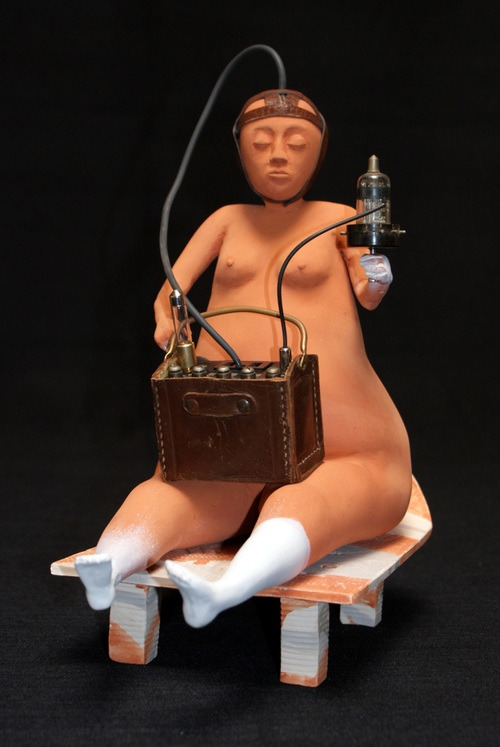Interview with Els Wenselaers, Belgian ceramic artist
Els Wenselaers
Category: Spotlight
Author: Ileana Surducan
Published in Ceramics Now Magazine Issue 2What made you choose ceramics as a way of expressing yourself?
Clay is as good as any other medium, it is a material with lots of possibilities but it doesn’t influence my personal perception of art. Sometimes because of its limitations in format, in height, due to the measures of my kiln I have to find other solutions than I used before, but that are technical issues. I have also used other materials like papier maché before but the outcome of my figurines would be the same.
What is for you the importance of figurative representation?
It’s the essence of my work. It wouldn’t be possible for me to make work if my thoughts and feelings are not involved. All of them have a meaning and reflect my personal view on society. It’s not necessary for the public to understand it, you can enjoy them without knowing the background, but I need to be able to make them. Some of my works have a spiritual dimension. Love, understanding and insight, the meaning of existence - of evil, the happiness of life and the tragedy of death affect us, but are by themselves invisible. You can see it as a spiritual quest in which I will not flee, but indeed want to decompose and play with. The human figure in this case is the most suitable.
Els Wenselaers: The Brain Controller, 2009, Ceramics, used materials, 25 x 29 x 16 cm.
> View more works by Els Wenselaers
Art no longer has to be “beautiful”, since the beauty of an object is derived not only from its appearance, but also from it’s concept and use. Tell us more about the aesthetic categories embodied by your work, and your motivation in choosing them.The followers of modernism only repeat a trick, a cheap shock effect - desecrating the beauty. It has been repeated so many times and now it belongs to the popular circuit. An authentic artist is always looking for new styles, new forms to express himself and will not be guided by expectations. The emptiness of existence can contrast strongly with its beauty and vice versa. Beauty, ugliness, two sides of the same coin. It’s the perception of it that counts; something very beautiful can be experienced as ugly when you discover the essence, the inner side of it. Art exists in many layers, for those who want to see it. My work can be considered as superficially aesthetic, but the deeper meaning is of a different order. There isn’t much beauty in the emptiness of an existence as in the Sisyphus series. “L’existence précède l’essence”. Existence precedes essence. (Jean Paul Sartre)
The Human Hybrids series emphasizes a new twist of an old idea. Humans with animal characteristics have been a constant presence in many cultures since thousands of years ago. Compared to their traditional representation, what do you want to express with your works?Indeed, one of the oldest known is an ivory sculpture, the Lion man of the Hohlenstein Stadel, Germany, a human-shaped figurine with a lion’s head, determined to be about 32,000 years old. Anthropomorphism is assigning human (behavioral) characteristics to animals. After reading an article about genetic engineering, I started on human hybrids. You can make goats, produce cobwebs or grow a human ear on the back of a mouse, etc. These techniques don’t stay within the walls of a laboratory. Since a number of years, you can find genetically manipulated fish in the aquarium trade. A familiar example is the glowfish: a gene of coral polyps was implanted in a zebrafish so that the fish has become luminous. Wherein ancient civilizations, men thought that they could get the spirit of the animal at their sides in the hunt by performing rituals, men now literally attempt to change certain qualities or appearances of people through genetic modification. Currently one is allowed to blend DNA of humans and animals and keep this hybrid alive up to 14 days, and this with the purpose to investigate the study of human bred organs for organ transplantation. There are both positive and negative elements to this evolution, but you can wonder who will eventually be the freak in the future: modified or unmodified humans. I want to start a dialogue about it with the Human Hybrids.
> Subscribe to Ceramics Now Magazine and sign up for the monthly email newsletter.

Ei kommentteja:
Lähetä kommentti